Travel Diary - Taj Mahal and other stuff - India in Melbourne Diaries
- Feb. 24, 2014, 4:02 p.m.
- |
- Public
It’s hard to write about a travel superlative like the Taj Mahal. There is a tendency on the one hand to inflate your experience with purple prose until it matches consensus; on the other, you’re tempted to debunk this undoubted wonder of the world. And there’s also the problem that pretty much everyone in the world with access to a television set has some idea what it looks like, so what’s the point in even describing it? What makes it more difficult still is that I’m going there at the wrong time of year. It’s now the monsoon season, which means that everything will be hot and sticky and uncomfortable, and that will inevitably colour my own subjective experience.
Most people ‘do’ the Taj Mahal as a day trip, with an air conditioned bus taking them to the front ticket office, picking them up at the end, and depositing them in a nice Delhi hotel six hours later. Determined to be different, and with time to spare, I instead spend about two and a half days in Agra, and stay at an obviously ‘local’ establishment a mile from the main train station. The early morning train from Delhi, however, is first class this time, a privilege I’d booked in the – correct – belief that I’d be extremely tired by this point of the journey. It’s less frantic than my earlier third class trip to Jaipur, but in the quiet carriage full of Westerners and well-to-do Indians it’s also as dull and uneventful as my early morning commute to work in Melbourne – nobody speaks to each other and most people are consulting the Times of India, Lonely Planet or their iPhone.
My accommodation, the misleadingly named ‘Grand Hotel’, is currently under repair during the off season, the lobby a splinter-filled worksite of timber and noise. While the restaurant food proves mercifully decent, the rest of the establishment, containing far more staff than patrons, is somewhat dilapidated: the television’s busted, the water is undrinkable even after boiling, and the fans rattle incessantly at night. It reminds me of the broken down motels one encounters in Australia in the off-highway towns. A walk to the nearby market reveals the slum railway grounds of Sultanpura, ridden with flies, roaming dogs, aggressive auto-rickshaw touts and homeless people sleeping on the pavement. In the thick, cloudy grey heat, a taste of chlorine always on my lips, it seems a dispiriting place, a reminder that Agra, the home of world’s wonder, is also a grim industrial smogland. Next to the hotel are DIY secondary schools and language centres run from refurnished garages, with well dressed boys and girls lining up outside the rusty shutters, their parents living in dirt but obsessively ensuring that their children are well presented for their classes. Some of the garages sport hopeful English monikers like ‘Britannia’ and ‘Royal’, and I suspect these may be the places that produce the counterfeit student visas that Australia is unsuccessfully trying to police.
My first stop is, of course, the Taj, which in this blistering morning heat is only lightly populated with tourists. Built in the seventeenth century, this is India’s masterpiece, the “teardrop on the cheek of eternity”, a monument to the Mughal emperor’s love for his wife, Mumtaz Mahal, and subsequently the place of a thousand poems, a million hopeful marriage proposals and perhaps a billion unimaginative desk calendars. Carved out of marble, it is indeed a glorious sight once you make your way through the entrance gates, and I take my time to study its towers and window designs, and the balcony from which the Yamuna River slithers past.
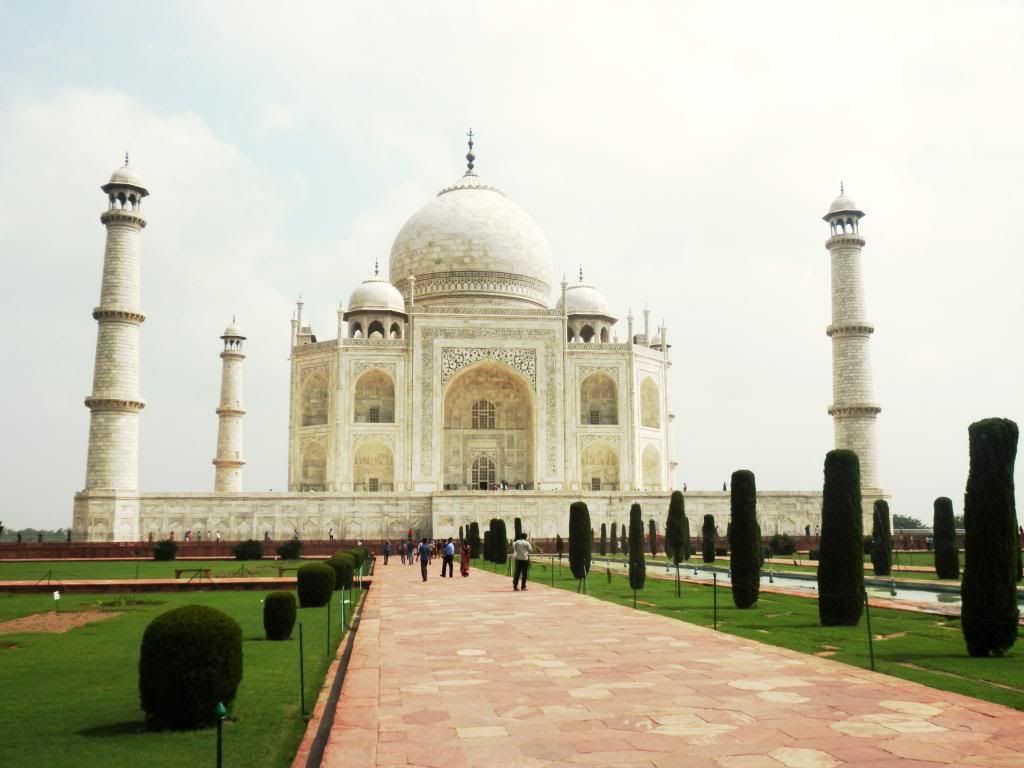
The Taj…
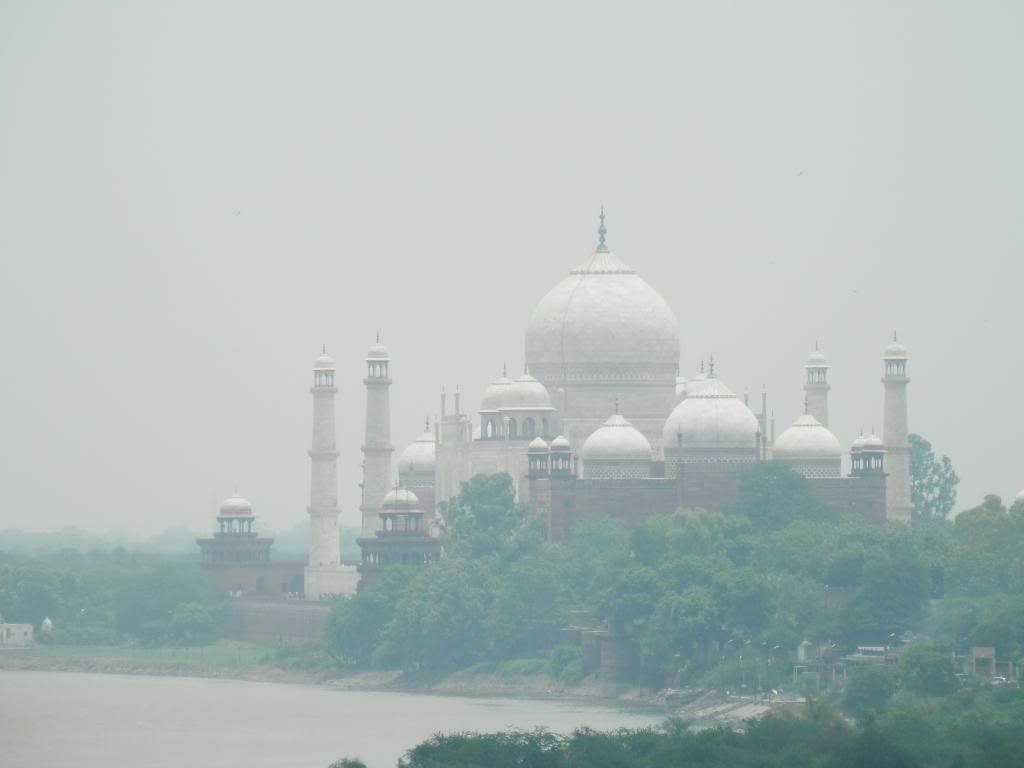
…and this is what the air that surrounds the Taj looks like
It’s awe inspiring of course, but there is a nagging thought as I dutifully photograph it from innumerable angles (including the perpendicular angle everybody photos it from): should I be enjoying this more than I am? For many people this is the highlight of their travel lives, but I’m still a bit tired from the Himalayan leg of my travels and in the 43 degree Celsius monsoonal conditions it is hard going. Perhaps it’s because the rituals of travel are the same as for dozens of other ‘important sites’. You pay the entry ticket, avoid the touts, take a few photos, wander around the places you’re supposed to go, and then leave. One’s memories will also be coloured by minor events during your one day at that the location, which for me include watching the social life of stray dogs at the outside walls, the piles of rubbish at the Mughal gardens outside, the thick muddy filth of the Yamuna, and the street side samosas for sale out on the main road (which taste the same no matter which I city I eat them in). Then there’ll be some beautifully ornate section of latticework on a side window that’ll also catch my eye, or an eagle hovering ten feet above the curved roof of the Taj, or an old woman in a spectacular sari chattering past me, and I’ll be glad to be here again.
The number two stop for the day is the Agra Fort, a sprawling complex of sixteenth century Mughal buildings and castle walls, and a more impressive relative of the Red Fort in Delhi. Many tourists head to the south edge of the fort for views of the Taj, only to be disappointed by a photographically unfriendly wall of thick grey smog. Every photo of the Taj that you’ve seen is (a) probably taken on a Friday, when the place is closed and therefore empty, and (b) within 500 metres of the white building, so you can’t see the pollution that would otherwise surround it. Nearby the Agra Fort a group of sports students in full cricket uniform are jogging in Agra’s urine splattered streets. I’m stunned at their human perseverance in this inhuman heat – no wonder Australia so regularly loses in the cricket to India. Even more impressive are the marathon runners doing training laps in the Sultanpura district, dodging the sleeping vagrants and wild dogs – these are hard, hard men. Before I sweat my last bodily fluid out by just walking a few miles, I visit the near-empty Itmad-Ud-Daulah’s Tomb, better known as the ‘Baby Taj’. It’s a pretty, unfairly neglected cousin of the Taj, with intricate marble designs and latticework. Whereas the Taj is largely empty inside, the interior of this smaller building is more elaborate and gem-decorated. As I wander around, a grumpy family group starts shouting at me in fiercely worded Hindi for no apparent reason, seemingly offended by my mere presence here (though all I’m doing is quietly walking around this site of no real religious significance while dressed respectably).
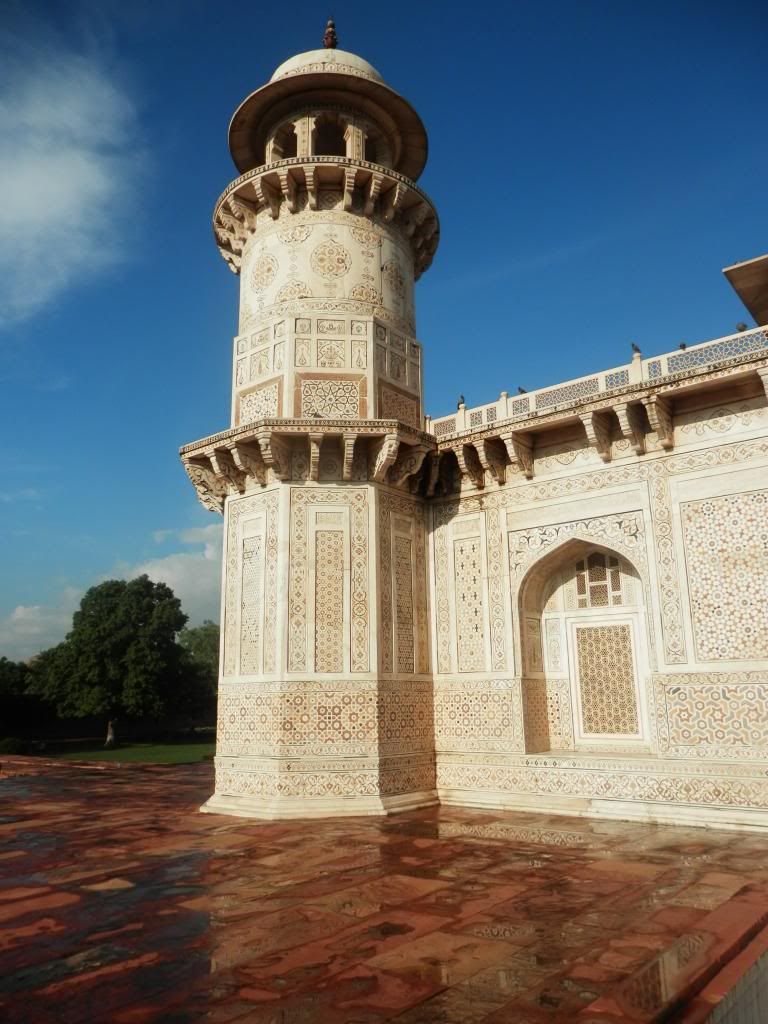
Baby Taj
The remainder of my time in Agra is largely spent reading in bed, avoiding the heat and trying to recover physically from the past four weeks. I do spend half a day at Fatehpur Sikri, though, a massive imperial complex abandoned in the eighteenth century, which, despite its scope and beauty, has been left untouched by Western tour buses (I only see one other foreign couple there the whole time). There is some bizarre attempt to extort money from me at a garage 500 metres from the front gate, whereby the taxi driver encourages me to pay for the services of some expensive English-speaking guide. Fed up with this harassment, I refuse curtly and instead get a cheaper guide at the front entrance, which is a long climb past resident goats and scammers to the arched entrance. The guide’s an overly insistent and impolite man (like many Indian guides), but at least shows me around the whole establishment, which includes a human Parcheesi board, where servants were used as pieces, and the giant two storey bed of the shah, which brings to mind the orgies of the Kama Sutra “Guess how many women fit on the bed?” my guide asks in one of his few cheerful sounding moments. “Ten.” “No, only six! Everybody says sixteen or twenty or thirty! But it only fit six!” There’s also an Elephant Gate, used to tie up the beast of the same name, which was trained to execute condemned prisoners by stamping on them, a form of punishment that’s sure to appear in the Game of Thrones series at some point.

Fatehpur Sikri
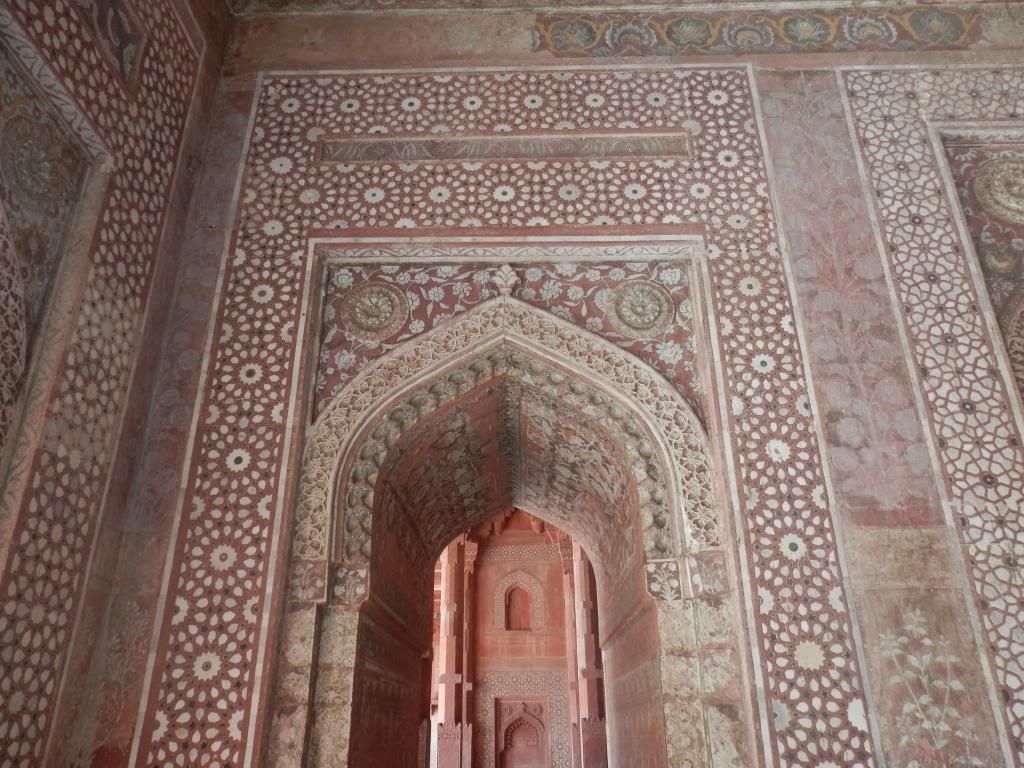
Fatehpur Sikri
My final morning is at the gardens on the other side of the Yamuna slime river, a different, less well known facde of the Taj, with the only other persons being a young couple romantically embracing among grazing parrots. It’s shortly after a heavy burst of rain, the moisture coiling up from the grounds, and from this angle, the building, this proclaimed masterpiece, seems to rise majestically from the dirt and heat of India, and seems more impressive because of this contrast.
The remainder of my time is travel time, and is largely a chore. At night, the street gang rats at Agra Cantonment train station swarming back and forth over the tracks are a wonder in themselves – every time a train pushes into the station, a hundred rat tails must be sliced off. Back in New Delhi at midnight, the auto-rickshaw driver searching for my hotel gets lost, and when he finally locates the place - both Lonely Planet and Googlemaps going to pot with the spider web slums of the city - we both find ourselves in the middle of a violent row on the street outside. On one side, a family is screaming at the hotel staff at the top of their lungs, threatening to call the police and kicking nearby cars; on the other, the hotel staff, flanked by heavyset ‘lads’ that they’ve conscripted into the fight, are brandishing clubs. However, it’s 1AM, and I only have a few hours in the city to go, so decide to chance my luck in this grimy establishment. I suspect that the row (which ended only when the police arrive) relates to the hotel’s attempt to extort money by holding passports hostage, something they try on me until after much argument I pull out my photographed copies of the passport and visa and collect the originals. The place is falling apart, a mass of rotting pipes, non-functioning plumbing and holed bath towels, like one of those New York hovels you see in old 1980s films (when people are on the run from the Mob or are members of the Blues Brothers). On this final night, though, I don’t really care, and at least get a few hours sleep before the plane flight home.
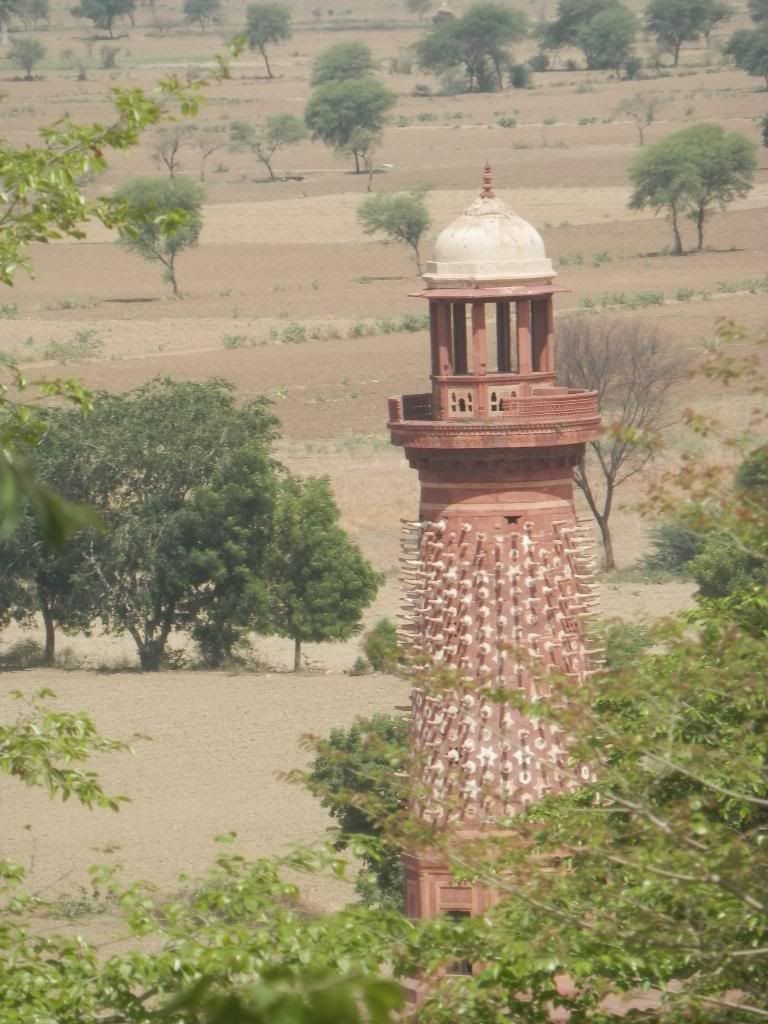
Elephant gate
On the plane, an upper class Indian man with a thin face and a jutting, officious chin – whose daughter has spent the last hour noisily rampaging back and forth the aisles unchecked and undeservedly pampered by the hostesses – gets loudly indignant when the Chinese hostess doesn’t understand his heavily accented request for some tea. His whinging goes on for at least an hour, with him demanding and getting his official apology and signing some formal complaint document that will at a minimum see the lovely, polite hostess - the prettiest sight for my eyes in the last 24 hours - reprimanded by her bosses or even sacked (the airline is pushing heavily on customer service quality and is known for its heavy penalties). I want to punch him out. Better still, I want him, just a few days, to have his pampered ass subjected to the same level of harassment that the average non-rich overseas traveller in India goes through: to leave a train station and be surrounded by passive-aggressive Australian men pretending to be your friend trying to give you misleading directions, extort money from you or otherwise trick you in some way; I want him to relinquish all of his rights to personal space the second he leaves the airport; I want his wife to be hooted and whistled at every half hour. Hours later and three Korean in-flight movies later, I’m back in wealthy, tree-lined Brighton, and notice how everything smells different, before realising that it is the absence of excrement that I’m now smelling.
No travel destination I’ve been too has such extremes of sights and smells and sounds, or left me with such contradictory emotions. On my desk at work, there is a Taj Mahal snow globe I got from a street vendor whose entire commercial profits were generated by selling identical Taj Mahal snow globes. It’s the only souvenir I bought. It’s cheap and it’s crappy, and it sprays grey flecks into the water when shaken, appropriate perhaps given the smoggy snow that surrounds the Taj Mahal in its non-photographed state. But whenever I shake the thing in lawyerly boredom, I’m reminded of the country, and it’s a fond memory. I remember the families singing out the soundtracks to Bollywood films on a crowded, rattling train, the ad hoc Hindu parties at 3,000m in the Himalayan foothills, the cheerful red clothed monks, and the spice-soaked food at every street corner. India is a nation that has been socially dissected, is disastrously impoverished and oppressed, not to mention hideously dirty and polluted, laden with a caste system that would be an insult to the Middle Ages. And yet sit in a manicured garden and watch the Taj Mahal, chat to travellers on a bustling Indian train, see the religious frenzy of the Golden Temple, walk in the imperious vastness of the Himalayas for a week, or relax on thin wooden boat in the middle of the Dal Lake, and it is clear that none of these negatives can ever be a reason for not going.
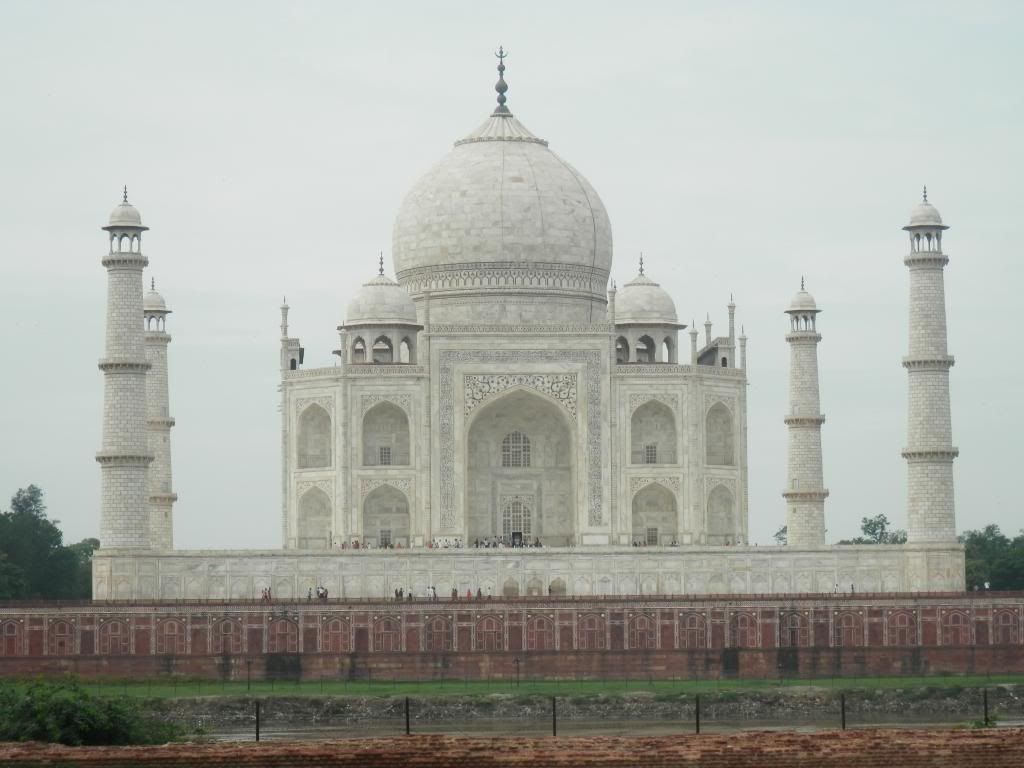
Taj - Rear view
Last updated August 26, 2014



Loading comments...